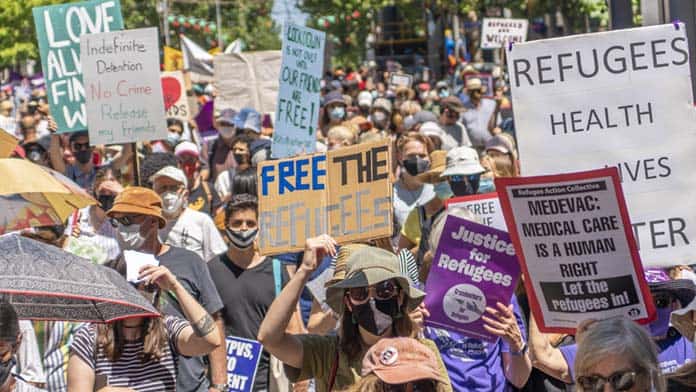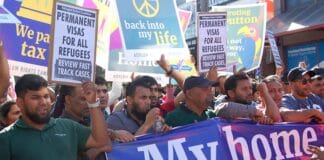The Coalition government has been forced onto the back foot by the refugee movement. After almost eight years in detention, including two years in hotel prisons, 48 Medevac refugees have now been released.
On Wednesday 20 January there were 26 released from the Park Hotel in Carlton and two from Melbourne Immigration Transit Accommodation (MITA) detention centre in Broadmeadows. Then the next day a further 20, including well know activists Mostafa Azimitabar (Moz) and Ramsiyar Sabanayagam, got out. Another 12 in MITA have been told they will get out on Thursday 28 January. More releases are expected.
This leaves 14 refugees in the Park Hotel in Melbourne, another 100 in the Kangaroo Point motel in Brisbane and small numbers in Darwin, Villawood in Sydney, Brisbane Immigration Transit Accommodation detention centre and MITA detention centre. They should not have to wait another day. Already one of those remaining in the Park Hotel has attempted self-harm, fearing he would not be released.
The immediate trigger for the releases was legal action many refugees lodged before the Federal Circuit Court. Home Affairs Minister Peter Dutton confirmed this, telling 2GB radio they had been released, “while the legal battle is ongoing”.
Dutton added, “It’s cheaper for people to be in the community than it is to be at hotel, or for us to be paying for them to be in detention”. But if that had been the real reason he would have released all refugees from detention into the community years ago.
Refugees are being dumped into the community with almost no support—just two weeks’ accommodation and three weeks’ financial assistance.
They are being released on insecure “final departure bridging visas”. The movement will need to fight for their right to access JobSeeker, and for permanent visas.
Border Force released a statement claiming the refugees could go to the US, back to Papua New Guinea (PNG) or Nauru, or their home countries. But the US deal is exhausted (with just handfuls of refugees still in the pipeline to go). PNG and Nauru are not taking back Australia’s refugees. Those brought here via Medevac have overwhelmingly been legally determined to be refugees, which means they also can’t be returned to their home countries.
The Coalition government has refused the NZ offer of 150 places per year. That means they have nowhere to go except Australia—and we should make them welcome here.
Protests
Whilst the trigger for the releases was the legal action, the protests inside and outside detention have played a crucial role. Protests by refugees in the Mantra and Park Hotels, and at Kangaroo Point in Brisbane, galvanised refugee supporters.
The Refugee Action Collective in Melbourne kept up protest action throughout the pandemic, because protesting for refugee rights was essential.
This led to new activists getting involved who initiated the daily protests outside the Mantra hotel. This culminated in a rally to free the refugees of 700 on Saturday 9 January, defying anti-protest laws that limit gatherings to 100 people.
At the same time over 10,000 are allowed to attend sporting events. But the risk of COVID-19 is 20 times less outside, and there has never been transmission from a rally in Australia. The rally successfully broke the 100 person limit without incident, because it had broad support, with speakers from the Greens, Labor and unions.
The protests, and the ongoing participation of tens of thousands in the wider refugee movement, meant that the Coalition’s legal problems could not be hidden away from view.
It was also the strength of the refugee struggles that first closed the original Manus detention centre in 2017 and then brought 200 refugees to Australia under the Medevac legislation.
Now is the time to press home the movement’s advantage, to fight to free the rest of the Medevac refugees, to end offshore processing, and to dismantle all of the architecture of deterrence.
Another major rally in Melbourne is planned for 2pm Saturday 13 February to welcome the freed refugees, to free the rest, for permanent visas, and to bring the 300 remaining in PNG and Nauru here.
Photo: Matt Hrkac






